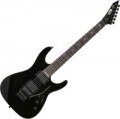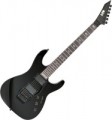Type
The type of tone block used in the construction of an electric guitar.
A timbre block is an “intermediary” between a pickup and a guitar output: a set of electronic circuits that provides signal transmission, and often also its processing (volume control, frequency correction, preamplification, etc.). In modern electric guitars, there are such types of tone blocks:
— Passive. Passive are called timbre blocks that do not require additional power sources during operation. Usually, such modules have the simplest design and functionality, adjustments are limited to changing the volume, as well as passively correcting frequencies (by “cutting off” the desired frequencies). At the same time, passive tone blocks are simple, compact, inexpensive and do not depend on batteries; and the necessary adjustments can be made on external equipment (anyway, the electric guitar will need to be connected to it). As a result, most modern instruments are equipped with this particular type of tone blocks.
—
Active. The key difference between a passive tone block is that it needs its own power source to work. Most often, this role is played by a PP3-type battery installed in a special socket in the body of an electric guitar. The need for power is due to the abundance of additional functions: active tone blocks are able to amplify the signal coming from the pickups, suppress interference, and even match the output impedance of the inst
...rument with the input of the amplifier. Yes, and the active method of tone control is more advanced than the passive one, it allows you to more accurately adjust the frequency ratio. On the other hand, active modules are noticeably more expensive, and without a battery, the tone block turns into a set of useless parts. However, such devices consume relatively little energy, and one battery lasts for quite a long time.
— Active/passive. Tone blocks that combine the capabilities of the two options described above. If there is power, such a module operates in active mode, and if there is no power, it turns into passive. Thus, the musician can enjoy all the advantages of the active tone block and at the same time not worry that the instrument will become completely useless due to a dead battery (although, of course, the tone block functionality is not so extensive in the passive mode). At the same time, combined modules are quite complex and expensive, and the real need for such versatility is rare. Therefore, this option has not received much distribution.Material
The material from which the body of an electric guitar is made. For models with cutouts (semi-acoustic, see "Type"), in this case, only the material of the back deck and sides can be taken into account, and data on the top deck is given separately (for more details, see "Deck Cover Material").
Now on the market there are cases of such trees:
red,
maple,
agatis,
ash,
alder.
It makes no sense to dwell on each of the materials found in modern electric guitars. Their variety is very large, however, unlike acoustic guitars, the body in this case does not play such a significant role in shaping the sound, and its material has a relatively small effect on the acoustic properties of the instrument (although the exact degree of such influence is a moot point). If you wish, you can find detailed data on a particular material in special sources, but in fact it makes sense to look primarily at the appearance of the instrument and its price category.
Mount type
A method of attaching the neck to the body used in an electric guitar.
—
Boltov. The most inexpensive and practical (in terms of production and repair technology) method of attachment: the neck is bolted to the body. Thanks to this, the assembly of the guitar is extremely simple, and the neck can be easily removed from the finished instrument for repair or even replacement with a new one. Note that although the bolt method is considered “low-cost” (and is found mainly in instruments of the corresponding level), it cannot be said that it is definitely worse than other options: guitars of this design have relatively weak sustain, but they give a bright, sharp tone with good attack. They can be used in almost any genre, but they are still considered the most suitable for heavy music.
—
Pasted. A neck mounted in a recess in the body and secured to the recess with epoxy or other adhesive. This design does not allow for such a powerful attack as on bolt necks, but it provides excellent sustain and a pleasant coloration of the sound. And in general, the adhesive connection is considered more advanced, because. better reveals the acoustic properties of wood. On the other hand, such tools are more complicated and more expensive, both in production and in repair, than “bolted” ones.
—
Through. The name of this method is due to the fact that the neck passes
...through the body through and through, to the “lower” (from the side of the bridge) butt. Many instruments of this type, from the back, look as if two additional pieces were attached to the solid piece of wood from which the neck and middle part of the body were carved to give the body the desired shape and width (although the manufacturing technique is, of course, somewhat more complicated). It is believed that the neck-through mount maximizes the capabilities of the wood and allows you to achieve the highest quality sound, with a flat frequency response and excellent sustain. However, such designs are very expensive, and besides, they require extremely careful handling — especially since the repair of a through neck is at best difficult and expensive, and often impossible at all. Note that this option is used mainly in basses, electric guitars with a through mounting method are produced much less frequently.Neck profile
Profile of a fretboard mounted on an electric guitar.
The profile of the neck is called its shape in section, more precisely, the shape of the back of the neck. This parameter practically does not affect the sound of the guitar, but it directly affects the convenience of playing. Ideally, the neck should “fill” the hand, but not be too large — otherwise it will not be possible to clasp it to the right extent.
Profiles are denoted by the letters C, D, V and U — depending on which letter the neck resembles in the section. Profile D is the flattest, C is slightly more convex, with almost uniform curvature along the entire length, U is more voluminous, with a wider profile in the area of the lining, and the V profile in its classic form has the form of an angle with a rounded top. There are also modifications of these options — for example, "thin", which provides for a reduced profile thickness, or "modern", with slightly improved (theoretically) ergonomics.
The most popular profile types are
C,
U and their "modern" (modern) modifications. The C profile is almost semi-circular, the U profile is more voluminous, at the fingerboard its edges are almost parallel and only closer to the back of the neck are sharply rounded. The terms
modern C and
modern U refer to various improved versions of these profiles, their f
...orm may be different.
In fact, the choice of neck profile depends solely on the guitarist's personal preferences, the characteristics of his hands and his preferred playing technique. Thus, there is no "perfect" profile shape — in each case, the optimal choice will be different. The perfect option is to try several types of profile "live", decide which one will be more convenient, and choose an instrument with a neck of the same or similar profile shape.
